If you have olive trees growing locally, or can access olive leaves and immature fruit, you can make your own olive leaf extract. Olive leaf extract is a helpful immune booster, and a good buddy in any natural defense against cold and flu.
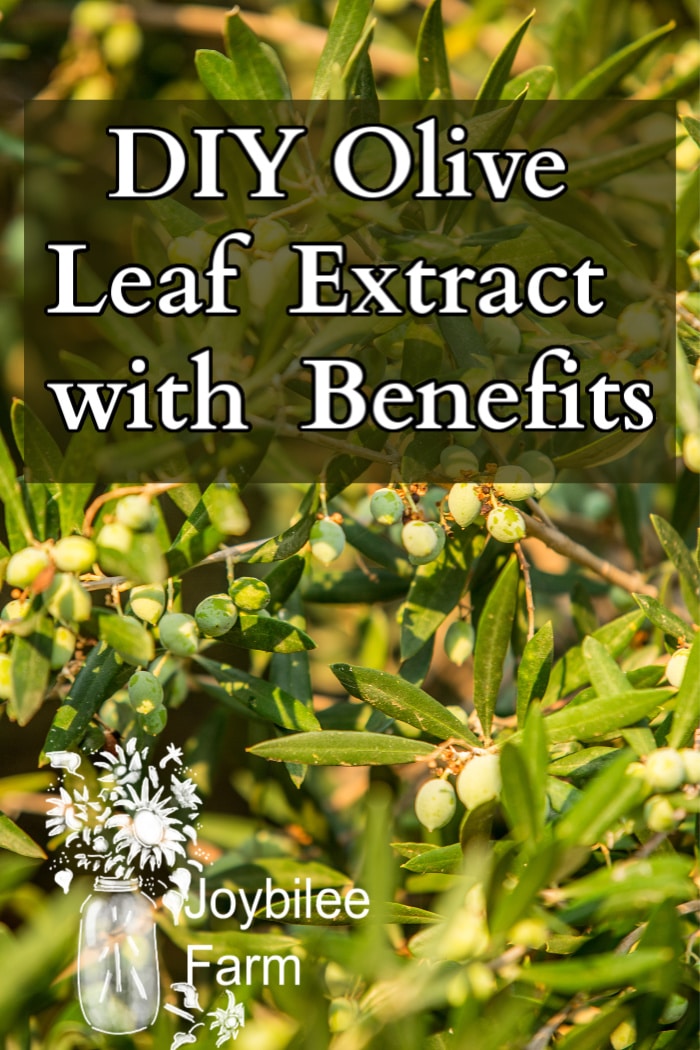
Sarah is working in Jerusalem on a two year assignment with a Christian aid organization. When she arrived in the city last May, it was the pruning season. When out for a walk she spotted an olive branch that had been pruned from a tree, behind a garden wall. The branch had fallen into the street. As an herbalist, Sarah recognized the treasure and carried it home. She stripped the leaves from the branch along with the immature olives, and made some herbal medicine. Recently she had an opportunity to test out the medicine, when sickness ran through the office staff at her work. I asked her to tell you about her experience making olive leaf tincture in her apartment in Jerusalem.
The Olive Tree
The olive tree (Olea europaea) is the tree of life. Olives flourish in warm, temperate climates. While they are native to the Mediterranean basin, they can also be successfully grown in California, in Arizona, and in zone 8 or warmer areas. They can withstand a few degrees of frost, slight snows, and thrive in dry desert conditions. In Europe olives are grown all around the Mediterranean. In the UK olives are often grown as ornamental specimen trees, but the climate is insufficient to ripen the fruit.
In areas where olives are native, they are surprisingly resilient. As one Israeli tour guide said, “you can cut down an olive, pave over it, and in a year or so a bulge will start. Then a crack will appear, and before you know it the olive is growing back out of the ground.” A well-established olive can overcome many challenges.
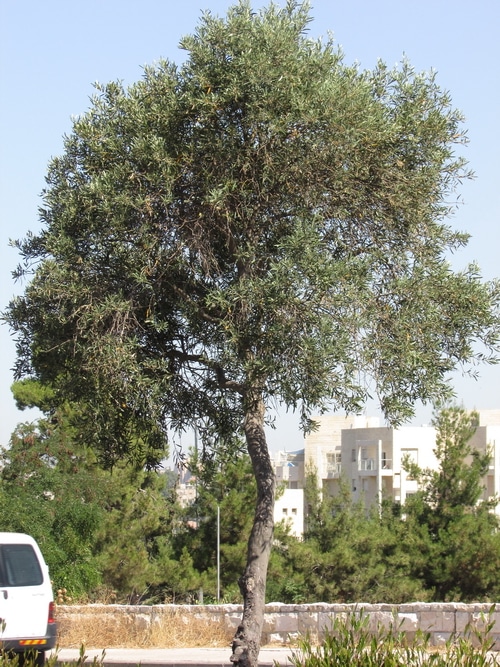
Olive tree in Jerusalem, Israel.
Olives are evergreen, holding on to their leaves year round. If you live in an area where olives grow, you may find them growing when you need them most. While the fruit ripens in late fall, the leaves can be gathered anytime for teas and tinctures.
Olive leaves are a grey-green, narrow and sharply pointed growing as opposites. The fruits are a medium green, round, and hard for most of the growing season, ripening to black only late in the fall. An old olive will have a twisted and gnarled trunk, while a young olive may have a few extra shoots growing near its base. The bark of an olive is light grey in color and smooth in younger growth. Older bark is thicker and fairly rough. Olives have a very long life span, with some olive trees believed to be up to, or over, 2000 years old. This includes the trees in the “Garden of Gethsemane” on the Mt. of Olives in Jerusalem.
The Tree of Life
The olive tree has been called the “Tree of Life”. The fruit is useful for nutrition, as well as oil for both food and fuel, while the leaves have been used medicinally for thousands of years.

Olive Tree in Jerusalem, Israel.
Olive Leaf Extract as an Herbal Remedy
Olive leaves are bitter and astringent. As a bitter they stimulate bile flow and support the liver and digestion. Olive leaf extract helps lower blood sugar. Insulin dependent diabetics therefore should use caution if supplementing with olive leaf. Olive leaf tea is a traditional remedy in Europe to lower blood pressure.
Olive leaves are anti-microbial, anti-viral, anti-inflammatory, and antiseptic. This makes them useful to fight infection, and other feverish conditions, and to stave off a cold or the flu. Buhner in Herbal Antivirals, lists olive leaf as an anti-influenza herb and supplement. Olive leaf is anti-microbial, and anti-viral. It protects the lungs from damage and is useful both in preventing viruses from replicating and in protecting the lungs during a virus that you can’t seem to shake. (Buhner, p. 45 – 57).
Olive Leaf Tea
Medicinally speaking, olive leaves can be used as either a tea or a tincture. Olive leaves have a bitter taste, so when making a tea try blending them with a sweeter herb, like peppermint or ginger. To make a tea take 1 tablespoon of the dried leaves in 1 cup of boiling water. Steep in a covered tea pot for 15 minutes. Drink two cups daily as a preventative.
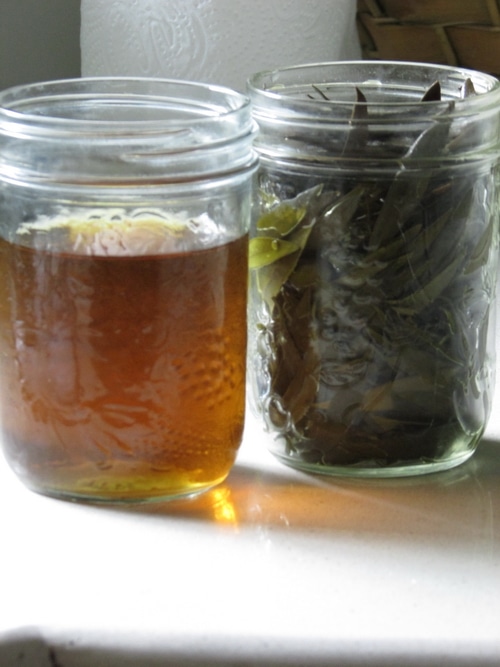
Olive Leaf Extract Tincture
Making Olive Leaf Tincture:
Olive leaves can be tinctured at any stage in their development. I used leaf tips from a mature branch that had been pruned from a local tree. Thanks to a rather hefty harvest of leaf tips from this branch, I dried some and tinctured some. The dry branches could be used for tincture at a later date, or used for tea.
(If you are new to herbal medicine see How to Make a Tincture here.)
Print
Olive Leaf Tincture
Description
Make an anti-viral olive leaf tincture with local olive leaves for your next cold and flu season.
Ingredients
- 1 1/2 cups of olive leaves, dried
- 2 cups of vodka (at least 40% alcohol)
- Glass jar with tight fitting lid
- Cloth or sieve to strain the tincture
Instructions
- While olives are a naturally dry plant, the leaves should be washed to get rid of dust and allowed to dry overnight after washing. This insures that there is no added dust, insects, or lingering residues in your tincture.
- Once the leaves have been washed and dried overnight, you can make the tincture.
Fill a pint or quart, wide-mouth jar with leaves. If you have a lot of olive leaves you can strip them from the stem, I left my olive leaves on the stem since I only had a few. - Once the jar is comfortably full, pour vodka or glycerine over the leaves to cover. Vodka used in tinctures should be at least 40% alcohol. For a specific measurement, a 1:5 ratio can be used. That is, one part dried olive leaf by weight to five parts alcohol by volume. I simply filled the jar half full of olive leaves and covered the leaves with vodka.
- Store your jar of steeping olive leaves in a dark cupboard or other place away from direct sunlight. Shake nightly, or as often as you remember to. Let the tincture steep for 4 to 6 weeks.
- After 4 to 6 weeks you can strain the olive leaves out of your tincture and transfer the green toned vodka tincture to a storage container or jar. The olive leaves are very dry, and absorb very little of the alcohol. Strain using a stainless steel mesh strainer, or just pour off the vodka through a standard tea strainer and shake off the leaves by hand. You do not need to press out the tincture from the leaves due to how dry the leaves are.
- If you inadvertently forget about your steeping elixir, there is no problem. Just strain it when you do remember it, after 4 to 6 weeks.
- Use a dark colored amber bottle for storage, or if you only have clear glass, store the tincture in a dark cupboard.
Notes
Dosages: 1 to 2 ml of tincture up to 3 times a day. This can be increased if you are fighting a virus or infection, up to 5ml, 2 or 3 times a day.
Ingredients:
1 1/2 cups of olive leaves, dried
2 cups of vodka (at least 40% alcohol)
Glass jar with tight fitting lid
Cloth or sieve to strain the tincture
Method:
The summer olive leaves will have small olives attached; these can be safely dried with the leaves and used in the tincture or tea.
While olives are a naturally dry plant, the leaves should be washed to get rid of dust and allowed to dry overnight after washing. This insures that there is no added dust, insects, or lingering residues in your tincture.
Once the leaves have been washed and dried overnight, you can make the tincture.
Fill a pint or quart, wide-mouth jar with leaves. If you have a lot of olive leaves you can strip them from the stem, I left my olive leaves on the stem since I only had a few.
Once the jar is comfortably full, pour vodka or glycerine over the leaves to cover. Vodka used in tinctures should be at least 40% alcohol. For a specific measurement, a 1:5 ratio can be used. That is, one part dried olive leaf by weight to five parts alcohol by volume. I simply filled the jar half full of olive leaves and covered the leaves with vodka.
Store your jar of steeping olive leaves in a dark cupboard or other place away from direct sunlight. Shake nightly, or as often as you remember to. Let the tincture steep for 4 to 6 weeks.
After 4 to 6 weeks you can strain the olive leaves out of your tincture and transfer the green toned vodka tincture to a storage container or jar. The olive leaves are very dry, and absorb very little of the alcohol. Strain using a stainless steel mesh strainer, or just pour off the vodka through a standard tea strainer and shake off the leaves by hand. You do not need to press out the tincture from the leaves due to how dry the leaves are.
If you inadvertently forget about your steeping elixir, there is no problem. Just strain it when you do remember it, after 4 to 6 weeks.
Use a dark colored amber bottle for storage, or if you only have clear glass, store the tincture in a dark cupboard.
Dosages: 1 to 2 ml of tincture up to 3 times a day. This can be increased if you are fighting a virus or infection, up to 5ml, 2 or 3 times a day.
Olive Leaf Extract Materia Medica
Olives, or Olea europaea, is a surprisingly powerful and life-giving herb. While it is most commonly known for its yummy olives, beautifully patterned wood, and awesome oil, its leaves are also very valuable as an herbal medicine.
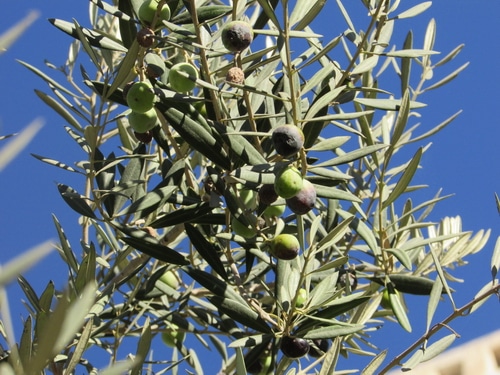
Olives ripening in September in Jerusalem, Israel.
Olive Leaf Extract Benefits
- antiatherogenic (prevents formation of plaque in the arteries)
- Anti-diabetic
- anti-HIV
- antihypertensive (lowers blood pressure)
- anti-inflammatory
- anti-microbial
- antioxidant,
- anti-viral
- bitter
- hepatic
- hypocholesterolemic (lowers cholesterol and protects the circulatory system)
- hypoglycemic (lowers blood sugar)
- protective against radiation damage
- support healthy thyroid function
Olive leaf tincture is active in the immune system, the digestive system, the circulatory system, and the glandular system.
Olive leaf extract is credited as both an anti-viral and an anti-bacterial agent. In historical usage, olive leaf tea was taken to lower fevers and reduce the impact of various bacteriological and viral diseases, including malaria. It has been found to act against viral agents, changing their pathways and preventing viral replication in infected cells. A 2003 study by Lee-Huang, et als found that Olive Leaf extract was effective in inhibiting the acute infection of HIV, and prevents a replication of the virus in the cells, and does so without toxicity in non-infected cells. The anti-HIV effect was dose dependent.
As an anti-microbial, olive leaf extract was active against MRSA, as well as Campylobacter jejuni, Helicobacter pylori and Staphylococcus aureu. (Sudjani, et als, 2009)
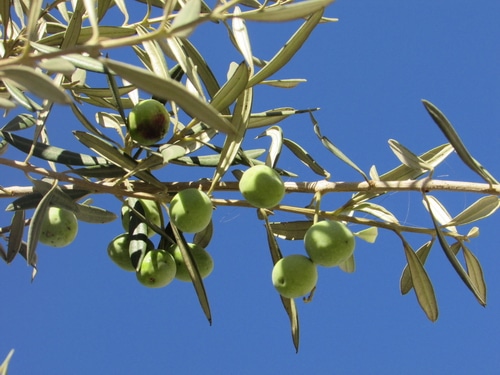
Immature olives on a branch.
It is also a powerful anti-oxidant, and works to support the cardiovascular system. As an anti-oxidant olive leaves protect the body from free radical damage. Some studies indicate that olive leaf extract helps control blood sugar, lowers blood pressure, reduces triglyceride levels, and helps prevent diabetes. In a 2011 study by Susalit, et als, Olive Leaf tincture was found to be as effective as pharmaceuticals in treating hypertension, with the added benefit of reducing triglyceride levels.
A South African study by Somova, et als, found that olive leaf extract from wild olive trees (Olea europaea subsp. cuspidata) also had the antihypertensive, diuretic, antiatherosclerotic, antioxidant and hypoglycemic effects of the European Olive leaf. They conclude that olive leaf isolates would be an inexpensive treatment for metabolic syndrome in those with salt-sensitive hypertension.
A 2004 study by Benavente-García, et als, demonstrated that the antioxidant effects of Olive Leaf extract protected from radiation damage.
Olive Leaf extract is also a potent anti-tumour supplement that promotes cancer cell death. A 2012 study by Tunca, et als, in the Journal of Cancer Research and Clinical Oncology found that extracts of olive leaf had an anticancer effect in several types of cancer. This confirms a 2007 study by Abaza, et als, that found that leukemia was inhibited by olive leaf extract.
For topical use, olive leaves are astringent and antiseptic, making them valuable for wound and injury treatment. Though, putting an alcohol based tincture on an open wound would not be recommended, the tincture can be applied to closed-injuries like bruises. A poultice of the leaves can be used on bruises and inflammation.
Contraindications:
Olive can interact with prescription medicine, and has the potential of increasing the action of blood thinning medications. It should be taken with caution if you are taking pain killers, aspirin, or willow bark, or any prescription medication. It can lower blood glucose levels, so if you are taking insulin, talk to your doctor before adding olive leaf tea or tincture supplements.
Sarah’s Story
Recently I [Sarah] was fighting some type of illness, I wasn’t sure if it was bacterial or viral. I added olive tincture to my standard defense, which is elderberry tincture, ginger and turmeric tincture, and oil of oregano. The illness never got past the “just feeling off” stage, and was fully gone within 48 hours.
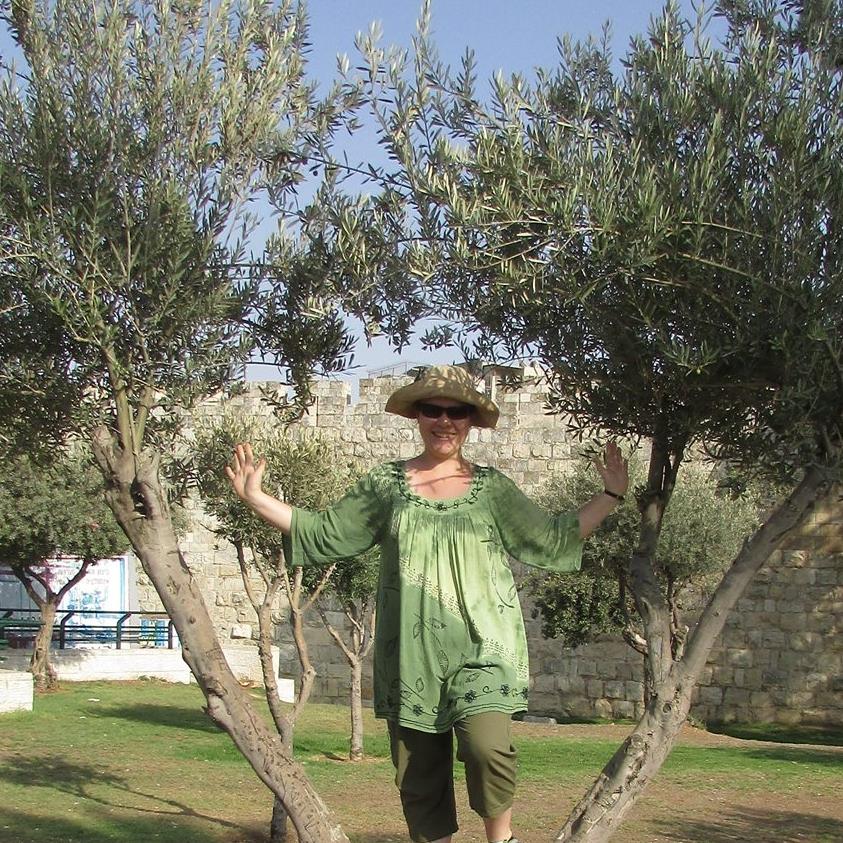
Olive tree growing near the Garden Tomb, in Jerusalem, Israel.
While I used a combination of anti-bacterial and anti-viral herbs, due to not knowing what the illness was, it was impressive to see how quickly the herbs acted against the illness. Co-workers taking pharmaceutical treatments for the illness were taking up to two weeks to kick the sickness. I’m continuing the olive tincture as a booster, since many of my coworkers are still fighting the illness and olive tincture has an immune boosting effect.
Sarah’s story is encouraging because it reminds us that the herbal medicine we need is right where we live. Sarah is temporarily in Jerusalem, away from the medicinal herbs that she is used to working with. Yet, she came across a pruned olive branch lying on the sidewalk, waiting for her. How many people that day walked past the olive branch, lying on the sidewalk, thinking it was rubbish?
Normally I’d suggest not gathering your herbs right next to the street. But in this case it wasn’t a major highway. The olive tree was growing behind a stone wall, protected from the dust of the roadway. This branch was dropped over the fence by the pruner, to remove it from the garden. (No olive trees were harmed in the making of this post.)
The herbs you have growing near you are subjected to the same microbes, viruses, and environmental challenges that you are facing. They have adapted and can help you overcome. Local herbs are potent allies in your quest for wellness, even if you live in a large, international city.
Your turn:
Olive leaf is a potent, life giving herb that might be growing in your neighborhood. The leaves are there for you to harvest year round. If you live in a zone 7 or warmer, you may be able to grow an olive, the tree of life.
What’s your biggest challenge in regards to making your own herbal medicine from locally growing plants?
References:
Abaza L, Talorete T, Yamada P, Kurita Y, Zarrouk M, Isoda H (2007) Induction of growth inhibition and differentiation of human leukemia HL-60 cells by a Tunisian Gerboui olive leaf extract. Biosci Biotechnol Biochem 71:1306–1312
Buhner, Stephen Harrod. Herbal Anti-virals. Storey Publishing: North Adams, MA. (2013)
Fares R, Bazzi S, Baydoun SE, Abdel-Massih RM (2011) The antioxidant and anti-proliferative activity of the Lebanese Olea europaea Extract. Plant Foods Hum Nutr 66:58–63
Fritchey, Philip. Practical Herbalism. Whitman Publications: Warsaw, IN. (2004)
Lee-Huang, Sylvia, et als. Anti-HIV activity of olive leaf extract (OLE) and modulation of host cell gene expression by HIV-1 infection and OLE treatment, Biochemical and Biophysical Research Communications, Volume 307, Issue 4, 8 August 2003, Pages 1029–1037.
Sudjana, Aurelia N., et als. Antimicrobial activity of commercial Olea europaea (olive) leaf extract. International Journal of Antimicrobial Agents. Volume 33, Issue 5, May 2009, Pages 461–463.
Susalit, Endang, et als. Olive (Olea europaea) leaf extract effective in patients with stage-1 hypertension: Comparison with Captopril, Phytomedicine. Volume 18, Issue 4, 15 February 2011, Pages 251–258
Tierra, Michael. The Way of Herbs. Pocket Books: NY. (1998)
Tunca, B., Tezcan, G., Cecener, G. et al. Olea europaea leaf extract alters microRNA expression in human glioblastoma cells, J Cancer Res Clin Oncol (2012) 138: 1831. doi:10.1007/s00432-012-1261-8
Benavente-García, O., Castillo, J., Lorente, J., and Alcaraz, M. Radioprotective Effects In Vivo of Phenolics Extracted from Olea europaea L. Leaves Against X-Ray-Induced Chromosomal Damage: Comparative Study Versus Several Flavonoids and Sulfur-Containing Compounds, Journal of Medicinal Food. July 2004, 5(3): 125-135. doi:10.1089/10966200260398152.


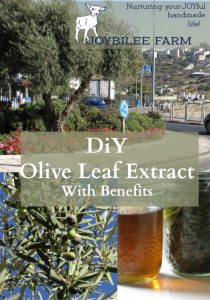

Any alcohol that is at least 40% can be used to make a tincture. If you don’t use alcohol keep the leaves dry and make tea as needed. The alcohol acts as the preservative in the tinctures. Tea is not shelf stable but the dry leaves are.
Many questions about this Olive Leaf Extract:
1. Must one always use vodka?
2. Could gin be used?
3. Can water be used for people who don’t do alcohol?
4. What is difference between extracts, tinctures, and oils?
Thank you so much for explaining things in easier terms to someone who has never done anything like this and am just embarking on a holistic life style.
Noah set forth a dove to see if the flood was over and land was available to replentish the earth. The dove came back with a universal symbol of peace, an olive tree branch. For those that believe, enough said.
Hi I have read about people drying the olive leaf at 100F for 12 hours
Would that harm or destroy any of the medicinal properties of the leaf ?